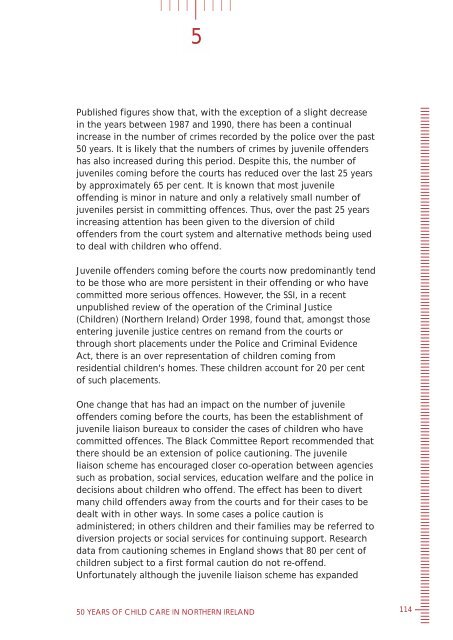childcare-50years
childcare-50years
childcare-50years
Create successful ePaper yourself
Turn your PDF publications into a flip-book with our unique Google optimized e-Paper software.
5<br />
Published figures show that, with the exception of a slight decrease<br />
in the years between 1987 and 1990, there has been a continual<br />
increase in the number of crimes recorded by the police over the past<br />
50 years. It is likely that the numbers of crimes by juvenile offenders<br />
has also increased during this period. Despite this, the number of<br />
juveniles coming before the courts has reduced over the last 25 years<br />
by approximately 65 per cent. It is known that most juvenile<br />
offending is minor in nature and only a relatively small number of<br />
juveniles persist in committing offences. Thus, over the past 25 years<br />
increasing attention has been given to the diversion of child<br />
offenders from the court system and alternative methods being used<br />
to deal with children who offend.<br />
Juvenile offenders coming before the courts now predominantly tend<br />
to be those who are more persistent in their offending or who have<br />
committed more serious offences. However, the SSI, in a recent<br />
unpublished review of the operation of the Criminal Justice<br />
(Children) (Northern Ireland) Order 1998, found that, amongst those<br />
entering juvenile justice centres on remand from the courts or<br />
through short placements under the Police and Criminal Evidence<br />
Act, there is an over representation of children coming from<br />
residential children's homes. These children account for 20 per cent<br />
of such placements.<br />
One change that has had an impact on the number of juvenile<br />
offenders coming before the courts, has been the establishment of<br />
juvenile liaison bureaux to consider the cases of children who have<br />
committed offences. The Black Committee Report recommended that<br />
there should be an extension of police cautioning. The juvenile<br />
liaison scheme has encouraged closer co-operation between agencies<br />
such as probation, social services, education welfare and the police in<br />
decisions about children who offend. The effect has been to divert<br />
many child offenders away from the courts and for their cases to be<br />
dealt with in other ways. In some cases a police caution is<br />
administered; in others children and their families may be referred to<br />
diversion projects or social services for continuing support. Research<br />
data from cautioning schemes in England shows that 80 per cent of<br />
children subject to a first formal caution do not re-offend.<br />
Unfortunately although the juvenile liaison scheme has expanded<br />
50 YEARS OF CHILD CARE IN NORTHERN IRELAND<br />
114


